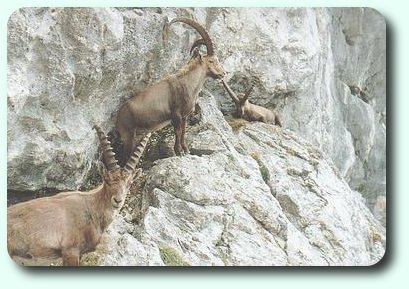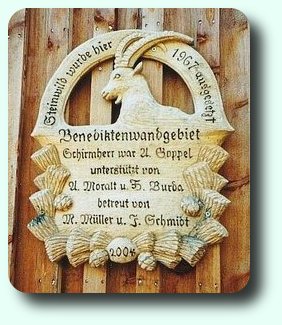


Ibexes at the Benediktenwand
Actually the ibexes pertain to the Central Alps. But in the
(19)sixties a lonesome ibex which had lost its way became the
progenitor of a flock of bavarian ibexes. Three nanny-goats had
been flown in from St.Gallen/Switzerland solely for it. Today the
population at the Benediktenwand counts about 70 animals.
During the last ice age ibexes had been common at the lowland.
17.000 years old rock-drawings in the famous Lascaux-cave in France
are witnesses. First after the melting of the glaciers the animals
withdraw to the high mountains of the Central Alps. Here the
predaceous animals rarely had chances against the high-skilled
climbers. Only mankind again and again had persecuted these
animals. In the middle ages they assumed supernatural power with
the ibexes because of their climbing arts. Additional in the noble
circles the breakneck hunting in steep walls was considered proof
of boldness and skill.
The hunting of ibexes became a real threat with the spread of gunpowder during the 15. century. Highly wanted by medical science, as a trophy or a festival roast three centuries later the last ibex of the Alps had been almost disappeared for ever. But the italien king Vittorio-Emanuele realized the danger. He made the hardcore poachers to well paid gamekeepers and so saved some dozens animals at Gran Paradiso. Any again coloniced animals since 1911 descend from this little herd.
Today they calculate the total at the entire Alps region to abaout 80.000 animals. Inspite of genetic risks a successful renaturalization. Ibexes seem to be tolerant to inbreeding. At least there are no troubles with interference of fertility. The four bavarian ibex colonies also have not to count with negative consequences of inbreeding. But the rate of growth of the some hundred animals is considerably smaller than with their consanguinity at the Central Alps. The agreeable consequence: Rarely will they be hunted and so they are very gentle.

At the Benediktenwand they are actually useful. The area round
the Probstalm, some hundred meters below the summits, is especially
worth to be protected because of its flora. The ibexes browse the
meadows and so act against the spreading of bushes. Nevertheless
none of the four bavarian ibex colonies are permanently safe,
following the meaning of experts.
Ibexes are suited to dry regions. Therefore they live best in
the high steep Central Alps where there are southern slopes which
are warmed by the sun in wintertime. At the Benediktenwand the
ibexes during the last years had had luck because of little amount
of snow. And since it seems that the climate will be warmer the
bavarian regions will be still more friendly for ibexes. But with a
serie of hard wintertimes the ibexes could not survive.
Ibex populations like the bavarians which are small and near the
woods are only able to survive where are no predaceous animals. But
a renaturalization of wolfs or lynxes at Upper Bavaria this time is
not to be seen. Actually it looks not bad for the bavarian
ibexes.